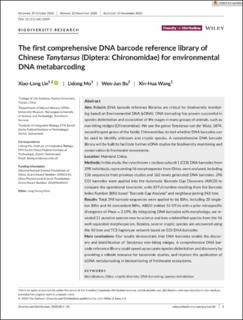| dc.contributor.author | Lin, Xiaolong | |
| dc.contributor.author | Mo, Lidong | |
| dc.contributor.author | Bu, Wen-Jun | |
| dc.contributor.author | Wang, Xin-Hua | |
| dc.date.accessioned | 2021-03-26T09:29:39Z | |
| dc.date.available | 2021-03-26T09:29:39Z | |
| dc.date.created | 2021-03-17T15:37:06Z | |
| dc.date.issued | 2020 | |
| dc.identifier.citation | Diversity and Distributions: A journal of biological invasions and biodiversity. 2020, . | en_US |
| dc.identifier.issn | 1366-9516 | |
| dc.identifier.uri | https://hdl.handle.net/11250/2735664 | |
| dc.description.abstract | Aim: Reliable DNA barcode reference libraries are critical for biodiversity monitoring based on Environmental DNA (eDNA). DNA barcoding has proven successful in species delimitation and association of life stages in many groups of animals, such as non-biting midges (Chironomidae). We use the genus Tanytarsus van der Wulp, 1874, second largest genus of the family Chironomidae, to test whether DNA barcodes can be used to identify unknown and cryptic species. A comprehensive DNA barcode library will be built to facilitate further eDNA studies for biodiversity monitoring and conservation in freshwater ecosystems. Location: Mainland China. Methods: In this study, the cytochrome c oxidase subunit 1 (COI) DNA barcodes from 298 individuals, representing 56 morphospecies from China, were analysed, including 136 sequences from previous studies and 162 newly generated DNA barcodes. 298 COI barcodes were applied into the Automatic Barcode Gap Discovery (ABGD) to compare the operational taxonomic units (OTU) number resulting from the Barcode Index Number (BIN) based “Barcode Gap Analysis” and neighbour joining (NJ) tree. Results: Total 298 barcode sequences were applied to 66 BINs, including 20 singleton BINs and 46 concordant BINs. ABGD yielded 55 OTUs with a prior intraspecific divergence of Pmax = 3.59%. By Integrating DNA barcodes with morphology, we revealed 21 putative species new to science and two unidentified species from the 56 well-separated morphospecies. Besides, several cryptic species are uncovered using the NJ tree and TCS haplotype network based on COI DNA barcodes. Main conclusions: Our results demonstrate that DNA barcodes enable the discovery and identification of Tanytarsus non-biting midges. A comprehensive DNA barcode reference library could speed up accurate species delimitation and discovery by providing a reliable resource for taxonomic studies, and improve the application of eDNA metabarcoding in biomonitoring of freshwater ecosystems | en_US |
| dc.language.iso | eng | en_US |
| dc.publisher | Wiley Online Library | en_US |
| dc.rights | Navngivelse 4.0 Internasjonal | * |
| dc.rights.uri | http://creativecommons.org/licenses/by/4.0/deed.no | * |
| dc.title | The first comprehensive DNA barcode reference library of Chinese Tanytarsus (Diptera: Chironomidae) for environmental DNA metabarcoding | en_US |
| dc.type | Peer reviewed | en_US |
| dc.type | Journal article | en_US |
| dc.description.version | publishedVersion | en_US |
| dc.source.pagenumber | 10 | en_US |
| dc.source.journal | Diversity and Distributions: A journal of biological invasions and biodiversity | en_US |
| dc.identifier.doi | 10.1111/ddi.13209 | |
| dc.identifier.cristin | 1898765 | |
| dc.description.localcode | This is an open access article under the terms of the Creative Commons Attribution License, which permits use, distribution and reproduction in any medium, provided the original work is properly cited. © 2020 The Authors. Diversity and Distributions published by John Wiley & Sons Ltd. | en_US |
| cristin.ispublished | true | |
| cristin.fulltext | original | |
| cristin.qualitycode | 1 | |

